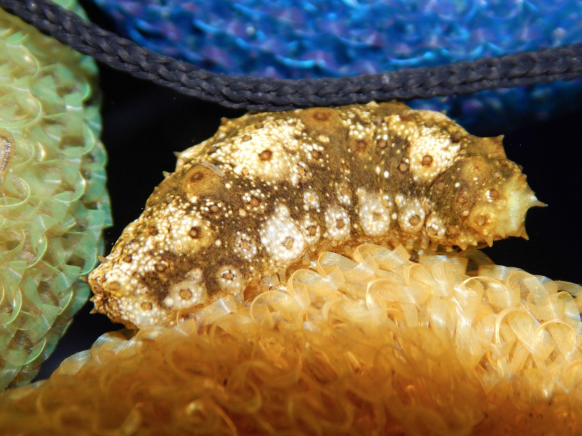The Reef Aquarium Industry is heavily reliant on invertebrate cleanup crew. Demand for cleanup crew organisms will only continue to sky-rocket with the popularity of the hobby. Economic and environmental criteria define the future of an ideal reef cleanup crew organism:
- Low Environmental Impact: limited fossil fuel consumption, low shipping distances, minimal impact on wild stocks/ecosystems.
- Aquaculturable: can be cultivated in captivity on a mass scale, ideally consuming a feed that is easy to obtain.
- High Market Availability: can be produced year-round, offered at a stable price, available in all life stages/sizes, and not swayed by seasonal availability.
- Ecological Function in the Reef Aquarium: high survivability, high longevity, presents no danger to fish/corals, reduces detritus/pests, or provides other profound Utility.
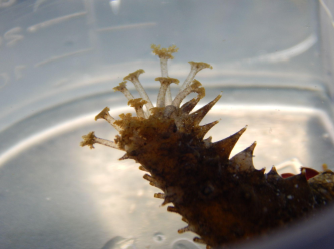
An All-In-One Orifice
The Florida Sea Cucumber, Holothuria floridana, is a champion of all these criteria. A member of the Holothuriidae, this species has evolved to stabilize the organic waste-load of tropical coral reefs. Sea Cucumbers have a magical all-in-one orifice responsible for eating, reproduction, and defecation. When grazing, long tentacles emerge from this orifice allowing the cucumber to aggregate and mobilize substrate/detritus into its gut.
The gastrointestinal system of sea cucumbers hosts an incredible array of microbes capable of utilizing an enormous diversity of resources from algae to bacteria to organic detritus. Inorganic particles and other indigestible food items are secreted out of the sea cucumber as loose ‘fecal sacs’. These fecal sacs break apart instantly when exposed to water flow and likely contain an assortment of beneficial microbes.
The Florida Sea Cucumber is a true generalist detritivore. This makes it ideal for adapting to whatever waste accumulates in a given aquarium. This species has no hard structures and is capable of cramming into the crevices of rockwork as well as penetrating deep into sand beds. Sea cucumbers seek out areas of low flow where organics/microbes have built up. When sea cucumbers quest into areas in search of forage, they actively introduce more oxygen into what could become ‘dead zones’.
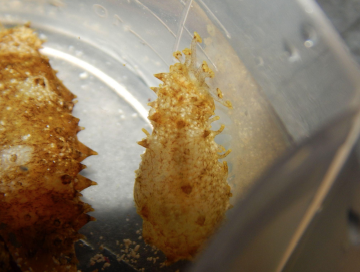
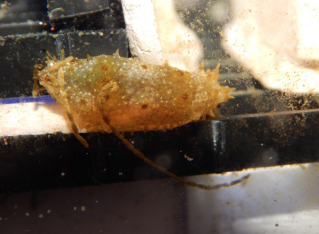
Detritus sinks
Sea cucumbers deposit fecal pellets in these areas, likely changing the microbiome of detritus sinks. Due to their specialized anatomy and gastrointestinal system, Holothuria floridana is capable of several profound ecological services in the reef aquarium.
Another ideal quality of this species is the fact that it is native to the Americas and can be easily aquacultured. Spawning occurs at night with egg and sperm transforming into various larval states (auricula/doliolaria/pentactula).
During this time, larvae feed on planktonic bacteria and microalgae. It takes about 20 to 26 days from fertilization until final metamorphosis into an adult sea cucumber. Normally, such a long larval duration would prevent this species from successfully recruiting in the home aquarium, but H.floridana is capable of ‘brooding’ its planktonic larvae on the outside of its skin. This is an incredible strategy that makes it extremely convenient to produce this species without any specialized larviculture equipment.
Arlenie Rogers, assistant professor at the University of Belize, has published several scientific papers detailing the species’ reproduction: “During broadcast spawning, some of the negatively buoyant and sticky oocytes settled on the adults where they remained anchored up to the pentactula stage (encapsulated).”
“Several wild adults collected in the Placencia Lagoon (Belize) each hosted ~2 propagules (eggs, blastulae, pentactulae, juveniles). The nursery habitat was characterized by high adult density, shallow seagrass beds close to mangroves, and mud-dominated substrata.”
“The present work illustrates a unique facultative offspring-adult association in a free-spawning lecithotrophic species of Holothuroidea, possibly representing a hybrid state between broadcasting and external brooding. This uncommon reproductive feature may ensure successful local recruitment in one of the most competitive habitats of the tropical Americas, where predation pressure is likely to be very high.”
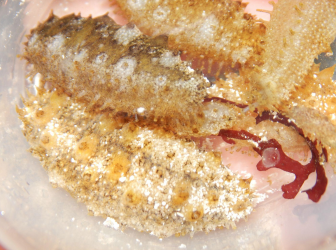
An ideal cleanup crew agent
The Florida Sea Cucumber is an ideal cleanup crew agent because it can be so easily aquacultured. This means that this species can be made available year-round, regardless of season. It can also be produced and sold at extremely small sizes which would be difficult to collect from the wild. These ‘nano cukes’ are ideal for smaller aquariums and for seeding early into larger systems.
Additionally, Holothuria floridana is a species of increasing commercial interest outside of the reef industry. Its ecological services can be applied to improve the performance of food shrimp and fish farming. In countries such as China, this species is prized as a food/nutraceutical item. Farang et al 2023 even identified oligosaccharides from H. floridana that are capable of inhibiting the reproduction of SARS-CoV-2.
There are many things Holothuria floridana can offer the reef aquarium industry. This species offers a way to actively recycle detritus in the aquarium, decreasing the toll on mechanical/chemical filtration. They can be aquacultured with minimal difficulty, meaning that they can be continuously produced, and sold at various sizes at a stabilized price.
Eventually, this species will likely be selectively bred for increased size and other beneficial traits so that its true value as a food item can become realized. Because of its beautiful utility, the future is looking bright for the noble Florida Sea Cucumber.


